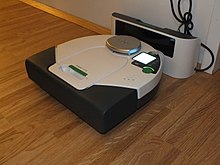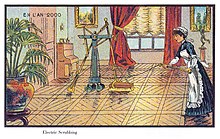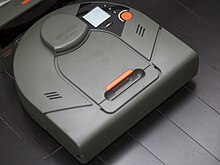Vacuum cleaner robots
Robotic vacuum cleaner - even Staubsaugroboter , robotic vacuum or robotic vacuum cleaner called - are household robots that automatically floors can be cleaned.
Since they were established in the late 1990s as the first service robots to find their way into everyday life , robots for private use have been growing. In 2018, 63,000 household robots were sold in Austria , almost 80% of which were vacuum cleaner robots.
function
Vacuum cleaner robots are often designed in the form of an approx. 30 cm large flat cylinder or a geometry based on it. When it comes to diameter and width, manufacturers use the distance between chair legs as a guide. Attempts are made to achieve the lowest possible overall height in order to be able to vacuum under furniture.
With increasing complexity, the models have a number of sensors with which they can orient themselves. Elaborate models also store information about rooms and the base station, to which they return independently after their work to recharge . With the help of complex electronics , these robots can run various programs, which means that all of the places in a room that are accessible to the vacuum cleaner can achieve a corresponding cleaning effect.
Cleaning function
Although not directly attributable to vacuum cleaners, models with static cloths that pick up dust from smooth hard floors are the simplest form of cleaning. Most devices, however, work on the principle of carpet cleaner combined with a vacuum function: cleaning is based on various rotating brushes or rollers with rubber wipers. The vacuum cleaners used are inefficient in comparison with conventional household vacuum cleaners. Practically all vacuum cleaner robots work without vacuum cleaner bags, the collection boxes with the house dust are simply emptied in the garbage can.
In addition to the general cleaning mode, many robots also have a so-called spot mode. The robot is placed on a place to be cleaned or controlled by remote control. There he then carries out an intensive cleaning of a small area, for example to vacuum up spilled material.
In March 2012, Stiftung Warentest tested two vacuum cleaner robots as an example. They were able to remove coarse dirt in tidy rooms quite successfully with daily use. On the carpet, however, they only removed dust superficially, and the vacuum cleaners tested in 2012 blown a large part of the fine dust back into the room because of their primitive filter technology. In the years that followed, models with HEPA filters were presented which, with their much better filter quality, are especially recommended for allergy sufferers .
According to a test report by Stiftung Warentest from 2015 with seven tested vacuum robots, they still do not replace classic cylinder vacuum cleaners in 2015, against which they perform poorly due to a lack of suction power. In the 2017 test, Stiftung Warentest tested six robots. As the suction power of the robots cannot be compared with conventional vacuum cleaners due to their design, they were tested as a separate product group.
Simple vacuum cleaner robots capture the environment with just a single collision sensor. If the robot encounters an obstacle, it changes direction. The first robot vacuum cleaners (example: Sichler Robo-Vacuum Cleaner ) did not need any electronics for this, with a simple spring mechanism the robot vacuum cleaner could turn on the spot after contact with an obstacle and take a different direction. With sufficient travel time, an area can be completely covered with this simple, random logic.
Complex vacuum cleaner robots use ultrasound , infrared light or laser to determine the distance to an object through reflections . Fall sensors enable stairs and landings to be recognized. Models with complex control electronics and sensors are able to follow edges or to orient themselves in space.
In the technically superior segment, most models map the rooms and systematically clean the surfaces or rooms. Model-specific, the existing collision sensors and various techniques known from inertial navigation systems, from odometry to lidar sensors, are used. This offers the advantage of a shorter cleaning process with practically no discharge points, which in turn leads to a higher area performance. On the other hand, chaotic cleaning systems offer the advantage of frequently driving over the same areas several times and thus also cleaning residual dirt that was not completely absorbed in the first pass. With manual vacuuming, this is mostly done very intuitively. If this is only done with a second pass in the case of the navigating robot, the time advantage is usually canceled out again. The created room plans and driving patterns can be viewed by robots with the appropriate software connection. iRobot caused a stir in 2017 when the idea of reselling the apartment plans to other companies was published. In addition to the idea of being able to use the data for other applications as well, concerns about data protection were expressed.
Things the robot can get caught in, such as: For example, cables or textiles lying around on the floor can lead to malfunctions or pull down the devices attached to them (e.g. table lamp from the table). The manufacturers therefore recommend removing this type of obstacle from the working area of the devices or restricting the working area accordingly with barriers.
Depending on the floor covering, there may be problems with individual models, as the fall sensors do not work on some dark tiles and the device then switches off to be on the safe side.
Cleaning time and area
Simpler models clean until the battery is exhausted. Other models adjust their cleaning time to the internally set cleaning time or a cleaning time calculated on the basis of measured distances. Many robots are able to automatically return to the charging station when the battery is exhausted and to recharge themselves independently. Devices with the appropriate mapping and navigation functions can continue cleaning activity at the last point after the charging process until the entire area covered has been cleaned. The cleaning time per battery charge is between half an hour and two hours for most models.
Models with a time control are able to operate unattended for several days without intervention. The limiting factor for fully autonomous service is then mostly the capacity of the dust container. Here, too, some models already have sensors that indicate a full container and then shut down the robot. The container size is usually only dimensioned for very few cleaning processes. A few robots can empty their internal dust containers at the base station on their own.
Information on areas that the robots can clean in one operation or with one battery charge very often come from dealers and review sites. Depending on the model, they range from 40 to over 180 m². In practice, the subsurface is one of the determining factors. On soft carpets, the energy consumption is much higher and the driving speed is often lower than on hard floors, such as B. Laminate.
equipment
In addition to the charging station normally supplied, remote controls and devices to limit the cleaning area are the most common accessories. Often it is already offered in a set.
Various techniques are used to limit the area. Some manufacturers use infrared light barriers that emit an invisible beam of light. Often they are also referred to as virtual walls or their English name virtual wall . If the robot detects the light beam, it changes its direction. In addition to linear light barriers that can block door openings or divide rooms, for example, there are also devices that create a restricted zone over a certain area. A common example of their use are animal feed bowls that should not be bumped. Other companies use magnetic strips that are laid out on the floor. Sensors in the robot recognize it in a similar way to infrared light barriers and avoid the locked area.
History and dissemination
history
In 2001 the world's first autonomous vacuum cleaner was commercially available: the Trilobite from Electrolux . The invented in Sweden and named after a three-lobed arthropods from the Paleozoic prototype had in 1996 experienced its first media appearance: in the BBC telecast Tomorrow's World . Its weaknesses - it collided with objects and stopped in front of walls, which is why some areas remained uncleaned - had to be cleared before it was ready for the market. In 2004 the revised edition appeared: the Trilobite 2.0 .
The presentation of a vacuum cleaner robot by the British technology company Dyson also dates back to 2001 : The DC06 was too heavy and too slow, however, and therefore never went into series production. In 2002, a Robovac from the American technology company iRobot followed : the Roomba equipped with a range of basic sensors . The device could detect obstacles and avoid them, as well as detect steep precipices and avoid falling down stairs. The Roomba quickly became popular and sparked further developments.
In 2010, Neato Robotics introduced the XV-11 robot vacuum with laser-based mapping instead of conventional ultrasound. In 2015, camera-based mapping from Dyson ( 360 Eye ) and iRobot ( Roomba 980 ) followed.
distribution
According to the International Federation of Robotics , around 940,000 vacuum cleaner robots were sold worldwide in 2008, almost 50% more than in 2007. By 2012, an increase from 4.4 million to 4.8 million for all household robots (vacuum cleaners, lawn mowers, window cleaners, etc.) . Ä.) to be expected. In 2018, more than 11.6 million robotic vacuum cleaners and floor cleaners were sold worldwide. If you add all other household robots such as lawn mowers and pool cleaners, there are over 12.2 million service robots. An increase to 25.5 million (30.4 minus 4.9 million for entertainment robots) is expected by 2020 and to 55.2 million (61.1 minus 5.9 million) household robots by 2022.
Manufacturer
Vacuum cleaner robots are mainly manufactured in Europe, USA and Asia. Manufacturers who specialize in robots can be found in the USA and Asia. In Europe, especially Germany, the classic cleaning equipment manufacturers are perfecting their product range with vacuum cleaner robots. The function and price differences between the models offered can be significant. The most important companies and their model series are listed below (as of 2020):
USA and Asia
- iRobot, USA: Roomba
- Neato Robotics, USA (with Vorwerk since 2017): Botvac
- ECOVACS Robotics , China: DEEBOT
- Techtronic Industries TTI, China: Dirt Devil
- ILIFE Robot, USA - in Europe ZACO, Germany: A and V series
- HOBOT, USA - in Europe Sichler, Germany: Legee
- eufy (brand of Anker Innovations), USA: RoboVac
- Samsung , South Korea: POWERbot
- Bagotte, USA: BG
- Xiaomi , China: Roborock (formerly Mi Robot Vacuum )
Europe
- Dyson, UK: Heurist
- Vorwerk , Germany: Kobold VR
- AEG , Germany: RX , in Switzerland Electrolux PUREi
- Kärcher , Germany: RC ( RoboCleaner )
- Rowenta , Germany: Explorer
- Miele , Germany: Scout RX
- Cecotec , Spain: Conga
Floor cleaning robot
More and more manufacturers of vacuum cleaner robots are now offering floor-mopping robot or combination devices as suction wiping robot on. The pure mopping robots are i. d. Usually seen as a new product line and sold under a different model name. The combination devices have so far only had a different name for Bagotte. (Status: 2020)
IRobot ( Braava jet ) and Sichler ( NX ) carry explicit mopping robots, while vacuum mopping robots are operated by Ecovacs, iLife / Zaco, Hobot, Rowenta and Bagotte ( BL ).
literature
- Heinz W. Katzenmeier: Self-made cleaning robot . Elektor, Aachen 2006, ISBN 3-89576-166-4 .
- Tod E. Kurt: Hacking Roomba , Wiley & Sons, Indianapolis, IN 2006, ISBN 978-0-470-07271-4 (English).
- Eberhard Veit: Robot vacuum cleaner for the household: Development of a functional model with a control algorithm. Munich 1999, DNB 960463364 (dissertation TU Munich 2000, 162 pages).
Web links
Individual evidence
- ↑ Stefanie Bruckbauer: The robotization of domestic households. In: elektro.at. June 17, 2019, accessed June 12, 2020 .
- ↑ Vacuum robots from iRobot and Samsung - More than a toy. In: test 03/12. Stiftung Warentest, March 29, 2012, accessed on September 5, 2017 .
- ↑ Vacuum robots in the test - what the little cleaning aids are good for. In: test 02/15. Stiftung Warentest, February 20, 2015, accessed on September 5, 2017 .
- ↑ Vacuum robots in the test - This is what autonomous vacuum cleaners do. In: test 02/17. Stiftung Warentest, February 3, 2017, accessed on September 5, 2017 .
- ↑ Examples of devices with lidar sensors: Neato Botvac D85, Vorwerk KoboldVR200 or Xiaomi Mi Robot
- ↑ Martin Holland: Roomba: manufacturer of the vacuum cleaner robot wants to sell cards of the apartments. In: heise.de. July 25, 2017. Retrieved July 12, 2018 .
- ↑ Vacuum cleaner robot: iRobot wants to share maps of user apartments. In: Spiegel Online . July 27, 2017, accessed January 21, 2020 .
- ↑ Help! Where am I? In: Computer Bild . No. 4 , 2018, p. 108 (The report refers to the iRobot Roomba 980 model. According to the article, the incompatibility with certain dark floors has been confirmed by the manufacturer.).
- ↑ a b The Trilobite 2.0. (No longer available online.) In: trilobite.electrolux.com. Archived from the original on December 31, 2006 ; accessed on August 14, 2020 (English).
- ↑ a b Invention of Robotic Vacuum Cleaners. In: vacuumcleanerhistory.com. Retrieved June 20, 2020 (English).
- ↑ Neato XV-11 robotic vacuum review. In: Engadget. August 24, 2010, accessed June 20, 2020 .
- ↑ "Dyson 360 Eye". A computer vacuums the living room. In: faz.net. September 5, 2014, accessed June 20, 2020 .
- ^ IRobot Brings Visual Mapping and Navigation to the Roomba 980. In: IEEE Spectrum. September 16, 2015, accessed June 20, 2020 .
- ^ Executive Summary of 1st World Robotics 2009 Industrial Robots, 2nd World Robotics 2009 Service Robots. (PDF; 51.9 KB) In: worldrobotics.org. International Federation of Robotics Statistical Department, September 16, 2009, archived from the original on February 15, 2010 ; accessed on January 24, 2010 (English).
- ↑ Executive Summary World Robotics 2019 Service Robots. (PDF) In: ifr.org. IFR International Federation of Robotics - Free Downloads, accessed June 13, 2020 .








